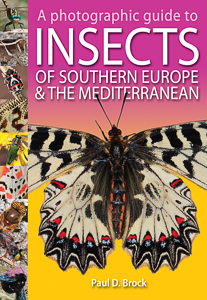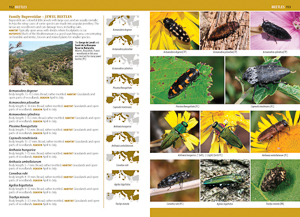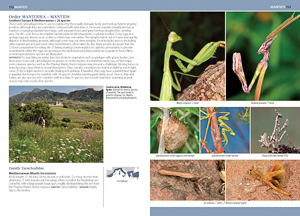 |
by Paul Brock
Published by Nature Bureau
Softback, 416 pages, ISBN: 9781874357797
From the publisher: "First of its kind, this new guide features many of the large, spectacular insects a visitor to southern Europe and the Mediterranean is likely to encounter. All the major insect groups of this region are covered in its 416 pages, including many endemic species. A magnificent and colourful insight into the insect fauna of this region".
This welcome title fills an important gap for the general naturalist who lives or spends time in southern Europe. For some decades now, Michael Chinery's field guide to northern and western Europe has enabled non-specialists there to place insects of all orders at least to family, and often to genus or species level. Travellers heading further south had nothing similar to help them. There exist specialist guides to particular groups - notably butterflies, moths and dragonflies - but nothing of a more general nature. As a result, I have spent hours typing descriptions of beetles and hemipterans into Google Images, hoping that someone, somewhere, has posted a picture of whatever bug I have found. To be fair, someone usually has, but this is something of a hit-and-miss way of identifying insects. An authoritative book, designed specifically for identifying the creatures most likely to be seen, is a much better option.
 |
The geographical area covered is large, including all of Spain, the South of France, Italy, the Balkans and part of Turkey. North Africa and the Middle East are excluded, though I suspect the book will still be useful for the coastal parts of these regions. Reflecting this coverage, the number of species potentially falling into the scope of the book is vast: the author reckons 66,000 is a conservative estimate. Set against this figure, the 1,500 or so described and illustrated represent a tiny fraction (about 2%). Those chosen for inclusion, however, are not equally distributed across all groups. The butterfly section, for example, includes the vast majority of species you are likely (or in some cases, quite unlikely) to see. There is a good selection of dragonflies too. Other groups are limited to representative species. This bias is reasonable. As a matter of psychological fact, the non-specialist is less likely to insist on naming that earwig than on naming that butterfly. In the same way, while there are a few striking and distinctive beetles it is nice to be able to recognise, only a devoted coleopterist, armed with specialist literature, will expect - or indeed want - to distinguish between all the many hundreds of similar ground beetles that cross his or her path. Life is too short to name and catalogue absolutely every plant and animal you see. I specialise in butterflies. Outside this narrow interest I am quite happy to recognise some creatures to species level and others to genus, family or even order.
That said, by defining the book's scope geographically rather than ecologically, the author has perhaps unnecessarily increased the amount of compression required. It rather surprised me to find high alpine specialists like Cynthia's Fritillary and Cranberry Blue included, for example. I do understand the logic here: the Alps are typically missed out of books on Britain and northern or western Europe (this book includes the southern Alps, though excludes Switzerland) and there are many important mountain ranges well within the southern areas this book covers. Nevertheless, I feel the book would have more coherence if it restricted itself to Mediterranean ecosystems - leaving room, perhaps, for another book embracing the true mountain species. Maybe my view on this is influenced by the fact I live in the Swiss Alps, far from the sea and more obviously set apart from coastal ecosystems than is the case in some southern mountain ranges.
The book is organised simply, clearly and systematically. Following a brief introduction, including an account of southern European habitats and a note on photographing insects, it proceeds to work through all the insect orders, from silverfish and bristletails to ants, bees and wasps. There is a pictorial guide to these groups inside the front covers and a glossary at the back. Each order, and where appropriate, suborder and family, opens with its own introduction, after which the selected species are described and illustrated. The text, together with a distribution map, appears on the left of every double-page spread and necessarily small but excellent photographs on the right, so you do not have to flip through the book cross-referencing picture and description. The result is a compact but eminently practical and user-friendly guide, suitable for carrying in a backpack and deploying in the field.
 |  |
I travel light when I trek across Spain looking for butterflies but will be sure to pack this book for my next trip.
The book is available through all good book stores, including those that are online.